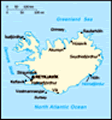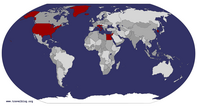Advertisement
Published: August 30th 2019
Before I get to today's activities, I would like to give information about the Ring Road.
From Wikipedia:
Route 1 or the
Ring Road (
Icelandic: Þjóðvegur 1 or Hringvegur) is a
national road in
Iceland that runs around the island and connects most of the inhabited parts of the country. The total length of the road is 1,332 kilometres (828 mi). Some of the most popular tourist attractions in Iceland, such as the
Seljalandsfoss and
Skógafoss waterfalls,
Dyrhólaey and the
Jökulsárlón glacier lagoon, are by the Ring Road.
The road was completed in 1974, coinciding with the 1,100th anniversary of
the country's settlement when the longest bridge in Iceland,
crossing the
Skeiðará river in the southeast, was opened.
celand%!p(MISSING)ng/290px-Route1%!i(MISSING)celand%!p(MISSING)ng)
The Ring Road of Iceland (as of 2004) and some towns it connects: (1)
Reykjavík; (2)
Borgarnes; (3)
Blönduós; (4)
Akureyri; (5)
Egilsstaðir; (6)
Höfn; (7)
Selfoss Today we traveled from near #4 to near #3. First on the agenda was Whale Watching from small fishing town called Dalvik. Some of us had elected to do an upgrade to a zodiac type boat that goes faster and can cover more area. I honestly
didn't remember that I had elected to do this. We put our red survival suits on and we were on our way. We did see a whale that was teasing us by coming up every now and then and then with a flip of its tail it was diving. This kept happening for about an hour. The boat guide decided to take us towards the ocean with the possibility of seeing whales or dolphins. No such luck. Oh well, worth a try. The best whale watching I've ever done was in Scammons Lagoon in Baja California when I took my kids there. We saw many mama and baby whales there.
We had a wonderful fish soup lunch, then continued driving north up the peninsula. Today was one of those days that had alot of driving. The road goes through tunnels because this northern part of Iceland gets alot of snow and sometimes road are impassable. Sindri told us a funny story about the pass we went over yesterday that is dangerous in winter and citizens were demanding a tunnel. The government finally agreed, put it out for bid & contract, and work started on the tunnel. They bored from
lowest elevation because it's easier to haul out the dirt & rock, then they hit hot underground water rushing out. The workers tried to continue but it was like working in a sauna because it was so hot. Apparently the television station showed up to interview them to see what they were doing about the hot water and the workers had on shorts, tool belt, and hard hats - so shirts. Sindri made a joke about them waiting for the rest of the Village People to show up and start singing YMCA. So they decided to go to the top and drill there which is more difficult because they had to haul out dirt and rock uphill. Then they hit a cold underground water stream and this one kept filling up the tunnel they had already drilled. Ah, the joys of drilling in Iceland. They couldn't continue and went back to the bottom and eventually a 1 year project turned into a 3 year project and the tunnel was completed.
We drove through:
Siglufjörður is a small fishing town in a narrow
fjord with the same name on the northern coast of
Iceland.
Siglufjörður is the site
of the
Herring Era Museum , which opened in 1994.
The town forms the setting for
Ragnar Jónasson's
Dark Iceland series of detective novels. It is also the setting for the first season and much of the second season of the internationally successful Icelandic crime drama television series
Trapped. Tröllaskagi is a peninsula in northern
Iceland between the
fjords of
Eyjafjörður and
Skagafjörður. The peninsula is mountainous, with several peaks reaching over 1,000 meters above sea level, the tallest being
Kerling (1,538 m). It is the part of Iceland with the highest elevation outside the
central highlands.
Blönduós is a town and municipality in the north of
Iceland with a population of 895 in 2018.
Like many towns and villages around Iceland,
Blönduós didn't emerge as a village until the late 19th century.
One of Blönduós' main characteristics is that the town is split into two parts by the glacial river
Blanda, for which it is named (Blöndu is an oblique
case of Blanda). The old part of town (
Icelandic: "gamli bærinn"), including many original houses from the late 19th and early 20th century, is located on the south side of the river. Many of the local companies, the
elementary school, supermarket, community center and sports facilities including a modern outdoor heated pool are located on the north side. On a hill above town is a church with striking architecture that is intended to resemble a volcanic crater.
Most of the industry and livelihood in Blönduós evolve around service for agriculture and tourism.
In recent years, the town has become known for its connection with textiles. A wool washery, Iceland's only textile museum
Heimilisiðnaðarsafnið and the
Icelandic Textile Center, featuring a residency program for international textile artists and scholars, are all located in Blönduós.
Information about the Icelandic language:
Icelandic (
/aɪsˈlændɪk/ (
 listen
listen); Icelandic: íslenska pronounced
(
 listen
listen)) is a
North Germanic language spoken in
Iceland. Along with
Faroese,
Norn, and Western
Norwegian it formerly constituted
West Nordic; while
Danish, Eastern Norwegian and
Swedish constituted
East Nordic. Modern Norwegian
Bokmål is influenced by both groups, leading the Nordic languages to be divided into mainland Scandinavian languages and
Insular Nordic (including Icelandic). Historically, it was the westernmost of the
Indo-European languages until the
Portuguese settlement in the Azores.
Most Western European languages have greatly reduced levels of
inflection, particularly noun
declension. In contrast, Icelandic retains a four-
case synthetic grammar
comparable to German, though considerably more conservative and synthetic. Icelandic is distinguished by a wide assortment of irregular declensions. Icelandic also has many instances of
oblique cases without any governing word, much like
Latin. The conservatism of the Icelandic language and its resultant near-isomorphism to
Old Norse (which is equivalently termed Old Icelandic by linguists) means that modern Icelanders can easily read the
Eddas, sagas, and other classic Old Norse literary works created in the tenth through thirteenth centuries.
The oldest preserved texts in Icelandic were written around 1100 AD. Many of the texts are based on poetry and laws traditionally preserved orally. The most famous of the texts, which were written in
Iceland from the 12th century onward, are the
Icelandic Sagas. They comprise the historical works and the
eddaic poems.
The language of the sagas is
Old Icelandic, a western dialect of
Old Norse.
Because they were so isolated, they didn't get the mixing effect that languages in Europe experienced, and the language hasn't changed substantially over 1000 years.
I want to say something about the colors of the plastic that wrap the bales of grass. Black or white is common colors, but we also see pink, blue, yellow, green.
The colored plastic cost more because they support certain causes: pink for breast cancer, blue for prostrate cancer, yellow for childhood leukemia, and I don't know about green. So when a farmer supports those causes the grass is wrapped in colored plastic. Sorry the picture is a little out of focus, I took it from the bus.
Then we arrived at Hotel Laugarbakki for the night. Tomorrow is a busy day, and the Aurora forecast for tomorrow night is good and clear skies. Hopefully we will see the Aurora.
Advertisement
Tot: 0.141s; Tpl: 0.024s; cc: 10; qc: 30; dbt: 0.0563s; 1; m:domysql w:travelblog (10.17.0.13); sld: 1;
; mem: 1.2mb







celand%!p(MISSING)ng/290px-Route1%!i(MISSING)celand%!p(MISSING)ng)



 Maroon
Maroon 















steve godlewski
non-member comment
enjoying your blog entries
Sounds like a beautiful place! Some of the history books pass fables/tales of Irish Hermit Monks who journeyed to and arrived prior to the vikings.Their bee hive like structures are said to still be found in remote areas near hot springs. The Celtic Culdee Church records these in their record.Point of interest.The Culdee is an early Celtic religious community-very mystical and contemplative in which men and women monks formed monastic communities.Very simular to cathar in France. Do not think their Iceland community survived, but possibly monumental ruins exist.Stay warm!